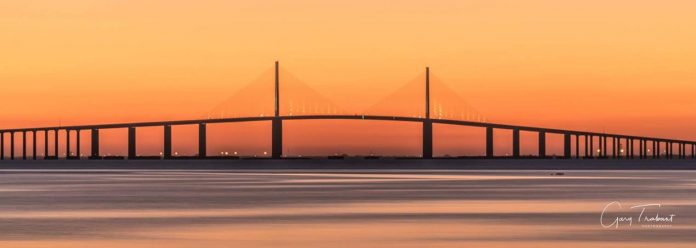Visitors to the Sunshine Skyway Fishing Piers always look forward to the opening of gag grouper season in the Tampa Bay region, and this week was no exception. The Skyway Piers might be one of the best places anywhere to catch a gag from a land-based structure. Mangrove snapper continued on a good bite – mostly at night but some during the day – with some fish over 16″ in length being reported in the past few days. Large Key West grunts joined the bite for anglers targeting snapper. Spanish mackerel continued on a decent bite along the deeper portions of both piers. Tarpon are becoming larger & more active by the day. Some large sharks & goliath grouper are also attracting anglers seeking larger game fish.
Gag grouper have been numerous all year at the Skyway Piers and anglers eagerly awaited the arrival of the open season. Fish in the keeper range have been reported and rumors of some very large fish are out there as well. Grouper habitat at the piers is vast and varied, but it seems that gags around the piers will use any bit of structure where they can hold and feed. This could be an artificial reef, a bridge piling, or even a simple change in bottom content that gives them a point of ambush. Of course, most anglers only target the artificial reefs, but plenty of keeper gags are taken elsewhere on the piers and some are holding on only the most minor structural changes.
There are three primary methods of grouper fishing at the piers. The first is the simplest and involves freshly procured dead baits fished on the bottom near the edges of the artificial reefs. A whole squid, chunk of ladyfish, or finger mullet might be the top choices for this method. The next procedure involves free-lining live baits like pinfish, pigfish, or blue runners over & around any type of potential holding structural elements. The final approach uses large diving plugs that are allowed to pass structure by using the tide and cranked down to where they bounce off of structural elements. Most all methods can use either heavy spinning or conventional tackle, with perhaps the plug anglers somewhat favoring spinning tackle. Braided or monofilament mainline in the 50 lb. to 80 lb. class is common and leader often ranges from 60 lb. to 100 lb. sizes. Hooks might range from 5/0 – 9/0 in size – depending on the bait choice. Gags have a size limit and thus pier hoop nets should be used over gaff hooks for any questionable fish. This allows for both the safe landing and release of fish that are short of the required size limit.
Spanish mackerel remained good near the end portions of each pier, with fish still seemingly holding near the main shipping channel more than is typical. Some limits of fish were still being taken and some fish over 20″ are now common in these limits. When fish hold deep, it is hard to beat a silver spoon fished behind a trolling sinker. The rig can be fished deep or burned across the top based upon mackerel location. Gotcha plugs also perform well at such times and a few split-shot sinkers can be added near the lure if extra depth is desired. Free-lining cut strip baits of scaled sardines or threadfin herring with a long shank hook and a few split-shots for depth is also a good approach for deeper mackerel. Rods can even be set on medium drag while the angler works artificial lures and most mackerel will simply hook themselves by the time you hear the drag.
Big sharks, tarpon, and goliath grouper are becoming common as we approach the summer solstice. If targeting sharks & goliaths, float a fresh ladyfish, stingray or bonito out with the tide and anchor your rod. Tarpon will take dead baits, but a live pass crab, pinfish, ladyfish, or shrimp might better interest the silver king. Serious tackle and a group of anglers is a huge help when targeting any of the monsters that cruise the mouth of the Tampa Bay Estuary. Almost all of the sharks your author has seen landed that exceeded the 10 foot range, and there have been many, involved a group of anglers assisting each other in the battle. Shark species that must be released according to FWC regulations are often photographed in the shallows after being walked down the pier using a team approach.
- The Skyway, Paul Bristow - August 24, 2018
- The Skyway, Paul Bristow - August 17, 2018
- The Skyway, Paul Bristow - August 10, 2018











